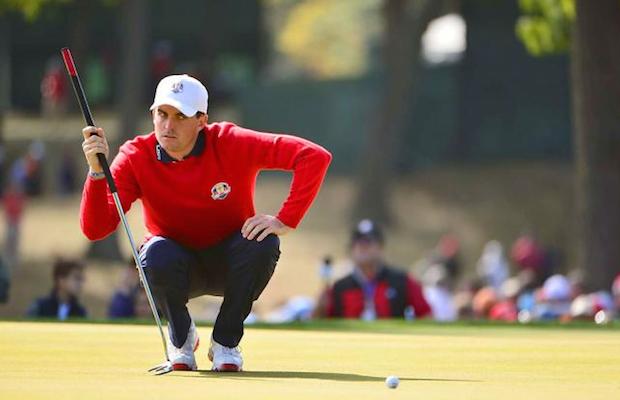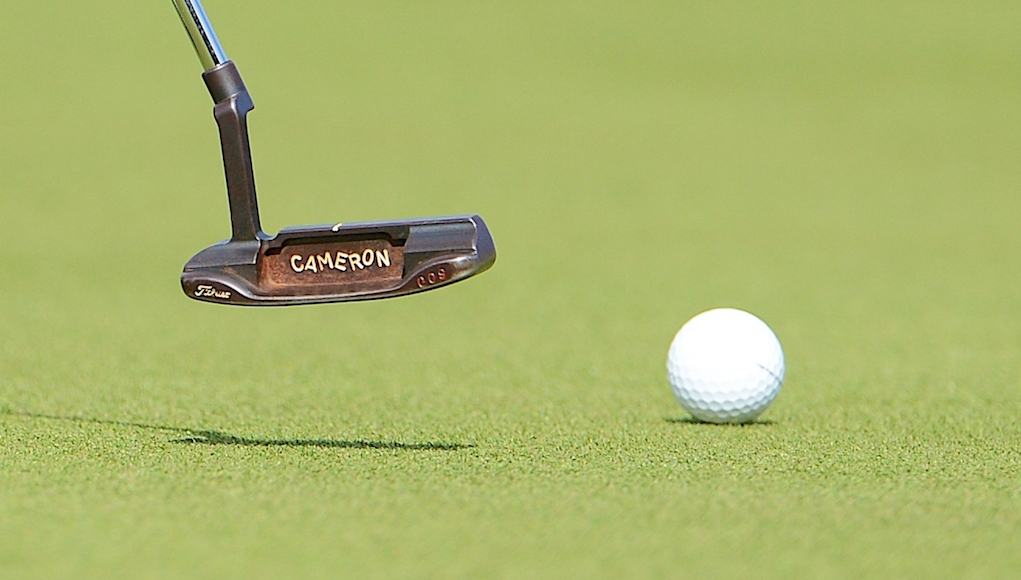Instruction
Think you’ve got to “give it a run” on must-make putts? Think again

With the Ryder Cup this week, I thought I’d share with you one of my pet peeves when it comes to making putts and rolling the ball the right speed. It drives me crazy when I hear announcers at tournaments say: “He can’t leave this putt short, he’s got to give it a run. It’s a must-make putt.”
What ends up happening when players follow this advice is that they hit the putt way too hard and it rolls something like 10 feet by the hole. The announcer comes back with, “Well, at least he gave it a good run.” But the reality is that a ball that rolls past the hole more than a couple of feet is travelling too fast to go in, even if it smacks square into the center of the hole. And nowhere does this happen more often than in Ryder Cup matches or match play, where sometimes the player does not have to hole out to finish the hole.
As a matter of mental practice, a good putter has learned how to control their putting “speed thoughts” to hole out, except when an outside situation interferes with the normal decisions process they use to hole a putt. And that outside influence is usually an outcome-based intrusion, which can come in the form of, “A must-make putt,” where they feel they have to hit their putt harder than usual.
Let’s enter two brains in a normal round of golf
- The mind of those trying to get to the next level of improvement in their games.
- The mind of the elite player.
The first person, who plays occasionally and practices on a limited basis, has a lot of wrong “speed thoughts” when they putt. They might hit the first couple of putts of the round well past the hole, well short of it or a combination of both. In their head, they are adjusting speed with the back-and-forth thoughts brought on by “don’t” sentences. Those sound like this: “don’t knock this one way past like last hole” or “don’t leave this way short again.”
Either way, they are going to blast it past the hole if they were short on the previous attempt, or leave it woefully short if they were way long on the hole before. They are not controlling their inner conversation very well, and by thinking about what they “don’t” want to do, they are promoting the opposite outcome.
“Don’t leave it short” usually results in hit a putt way past the hole. For example, I recently had one of my junior players complaining about hitting it too hard on one hole and too soft on the next hole. The player was constantly leaving the putt either six feet past the hole or six feet short of it. He was stuck on the ping-pong thought loop of “don’t hit this one too hard” followed by “don’t hit this one too soft.”
These are common thoughts that go to the brains of a player struggling with speed.
Both thought processes are detrimental to hitting the putt the right speed when you’re struggling. What I tell my players to do when this is happening is to think “do” thoughts, not “don’t” thoughts. I try to give them the mindset of the elite player who is thinking correctly over putts when struggling with speed.
So let’s look at the way a good putter’s mind works on a putt.
Once the elite player has finished considering the line and speed of the putt, their mind goes into execution mode.
“How do I need to hit this ball to get it to go the right distance on the line I select?”
Then, they either take a physical practice stroke to feel the “correct” speed or a mental one where the mind internally moves the body and they feel the stroke without taking a physical practice stroke. Each practice stroke is quiet, void of “don’t” or outcome thoughts, as the player feels the perfect speed and executes the motion that will roll the ball to the hole at the perfect speed. If it misses and comes up a little short or a little long, that’s alright. It is ok to be wrong if you are in control of your “speed thoughts.” Then they get set and hit it the speed they feel is correct without the “don’t leave it short” or “don’t knock it way past” thoughts of the poor putter.
Did you catch the first part of the above sentence? No matter what, they try to hit it the speed they feel is correct! So each practice stroke results in an inner conversation that if there were words for each stroke it would end up sounding like this:
“Yep, that’s the right speed” or “perfect speed, that’s the one.”
Inwardly, you are trying to calibrate a stroke with the mind quietly approving that this is the correct speed, disregarding previous outcomes that might have been too hard or too soft of a roll. It is this quiet recalibration to the correct speed that overcomes the “don’t” speed thoughts.
Here’s a relevant example from a past PGA Tour event.
Several years ago at the Zurich Classic in New Orleans, David Toms had about a 20-footer on the last hole to force a playoff. Once again, the announcers declared, “He’s got to get it there, he can’t leave it short.” So what happened? Toms took his time and decided on the read and speed of the putt. He took a couple of practice strokes and let it roll. The ball was dead in the center of the cup and came to a halt — one turn short of dropping and forcing a playoff.
The announcers groaned, “Oh how could he leave it short? He had to get it there!” From where I sat, I saw things differently. As a past player, I knew he didn’t intentionally leave the putt short. I knew he hit the putt with what he thought was the proper speed and put his best stroke and roll on it. Toms just happen to underestimate the correct speed and came up short instead of perfect. For this putt on this green at this time, he was just wrong about the speed. Nothing more.
Remember, there is a specific speed the ball has to be rolling for the hole to secure the ball. If the ball is going too fast when it gets airborne over the hole, the hole cannot collect it. This is called capture speed. It is governed by the laws of physics and we can’t cheat it no matter what we do. So when someone says, “Give it a roll,” make sure you focus your inner thoughts on picking the speed you think is correct without the “Don’t leave it short” thought and turn it loose.
Most times, a putt struck too hard doesn’t go in. Instead, focus on making a stroke that will roll the ball the perfect speed in your mind. If you happen to be wrong and the ball comes up short, oh well, tap it in. At least you tried to hit the ball with what you thought was the correct speed.
So as you enjoy the Ryder Cup, watch for the putts that the player “gives a run” and notice how far past they roll the ball if they miss. If it is a couple of feet then that is fine, but if it goes well past, you can bet the outside influence of not having to hole out and the inner concern about not leaving it short (“give it a chance”) entered into his head, which made him blast it too hard, thereby never really allowing the ball to arrive at the hole with the right amount of capture speed.
Best of luck to both teams, but from my academy I have to say, “Go USA!”
Instruction
The Wedge Guy: Beating the yips into submission

There may be no more painful affliction in golf than the “yips” – those uncontrollable and maddening little nervous twitches that prevent you from making a decent stroke on short putts. If you’ve never had them, consider yourself very fortunate (or possibly just very young). But I can assure you that when your most treacherous and feared golf shot is not the 195 yard approach over water with a quartering headwind…not the extra tight fairway with water left and sand right…not the soft bunker shot to a downhill pin with water on the other side…No, when your most feared shot is the remaining 2- 4-foot putt after hitting a great approach, recovery or lag putt, it makes the game almost painful.
And I’ve been fighting the yips (again) for a while now. It’s a recurring nightmare that has haunted me most of my adult life. I even had the yips when I was in my 20s, but I’ve beat them into submission off and on most of my adult life. But just recently, that nasty virus came to life once again. My lag putting has been very good, but when I get over one of those “you should make this” length putts, the entire nervous system seems to go haywire. I make great practice strokes, and then the most pitiful short-stroke or jab at the ball you can imagine. Sheesh.
But I’m a traditionalist, and do not look toward the long putter, belly putter, cross-hand, claw or other variation as the solution. My approach is to beat those damn yips into submission some other way. Here’s what I’m doing that is working pretty well, and I offer it to all of you who might have a similar affliction on the greens.
When you are over a short putt, forget the practice strokes…you want your natural eye-hand coordination to be unhindered by mechanics. Address your putt and take a good look at the hole, and back to the putter to ensure good alignment. Lighten your right hand grip on the putter and make sure that only the fingertips are in contact with the grip, to prevent you from getting to tight.
Then, take a long, long look at the hole to fill your entire mind and senses with the target. When you bring your head/eyes back to the ball, try to make a smooth, immediate move right into your backstroke — not even a second pause — and then let your hands and putter track right back together right back to where you were looking — the HOLE! Seeing the putter make contact with the ball, preferably even the forward edge of the ball – the side near the hole.
For me, this is working, but I am asking all of you to chime in with your own “home remedies” for the most aggravating and senseless of all golf maladies. It never hurts to have more to fall back on!
Instruction
Looking for a good golf instructor? Use this checklist

Over the last couple of decades, golf has become much more science-based. We measure swing speed, smash factor, angle of attack, strokes gained, and many other metrics that can really help golfers improve. But I often wonder if the advancement of golf’s “hard” sciences comes at the expense of the “soft” sciences.
Take, for example, golf instruction. Good golf instruction requires understanding swing mechanics and ball flight. But let’s take that as a given for PGA instructors. The other factors that make an instructor effective can be evaluated by social science, rather than launch monitors.
If you are a recreational golfer looking for a golf instructor, here are my top three points to consider.
1. Cultural mindset
What is “cultural mindset? To social scientists, it means whether a culture of genius or a culture of learning exists. In a golf instruction context, that may mean whether the teacher communicates a message that golf ability is something innate (you either have it or you don’t), or whether golf ability is something that can be learned. You want the latter!
It may sound obvious to suggest that you find a golf instructor who thinks you can improve, but my research suggests that it isn’t a given. In a large sample study of golf instructors, I found that when it came to recreational golfers, there was a wide range of belief systems. Some instructors strongly believed recreational golfers could improve through lessons. while others strongly believed they could not. And those beliefs manifested in the instructor’s feedback given to a student and the culture created for players.
2. Coping and self-modeling can beat role-modeling
Swing analysis technology is often preloaded with swings of PGA and LPGA Tour players. The swings of elite players are intended to be used for comparative purposes with golfers taking lessons. What social science tells us is that for novice and non-expert golfers, comparing swings to tour professionals can have the opposite effect of that intended. If you fit into the novice or non-expert category of golfer, you will learn more and be more motivated to change if you see yourself making a ‘better’ swing (self-modeling) or seeing your swing compared to a similar other (a coping model). Stay away from instructors who want to compare your swing with that of a tour player.
3. Learning theory basics
It is not a sexy selling point, but learning is a process, and that process is incremental – particularly for recreational adult players. Social science helps us understand this element of golf instruction. A good instructor will take learning slowly. He or she will give you just about enough information that challenges you, but is still manageable. The artful instructor will take time to decide what that one or two learning points are before jumping in to make full-scale swing changes. If the instructor moves too fast, you will probably leave the lesson with an arm’s length of swing thoughts and not really know which to focus on.
As an instructor, I develop a priority list of changes I want to make in a player’s technique. We then patiently and gradually work through that list. Beware of instructors who give you more than you can chew.
So if you are in the market for golf instruction, I encourage you to look beyond the X’s and O’s to find the right match!
Instruction
What Lottie Woad’s stunning debut win teaches every golfer

Most pros take months, even years, to win their first tournament. Lottie Woad needed exactly four days.
The 21-year-old from Surrey shot 21-under 267 at Dundonald Links to win the ISPS Handa Women’s Scottish Open by three shots — in her very first event as a professional. She’s only the third player in LPGA history to accomplish this feat, joining Rose Zhang (2023) and Beverly Hanson (1951).
But here’s what caught my attention as a coach: Woad didn’t win through miraculous putting or bombing 300-yard drives. She won through relentless precision and unshakeable composure. After watching her performance unfold, I’m convinced every golfer — from weekend warriors to scratch players — can steal pages from her playbook.
Precision Beats Power (And It’s Not Even Close)
Forget the driving contests. Woad proved that finding greens matters more than finding distance.
What Woad did:
• Hit it straight, hit it solid, give yourself chances
• Aimed for the fat parts of greens instead of chasing pins
• Let her putting do the talking after hitting safe targets
• As she said, “Everyone was chasing me today, and managed to maintain the lead and played really nicely down the stretch and hit a lot of good shots”
Why most golfers mess this up:
• They see a pin tucked behind a bunker and grab one more club to “go right at it”
• Distance becomes more important than accuracy
• They try to be heroic instead of smart
ACTION ITEM: For your next 10 rounds, aim for the center of every green regardless of pin position. Track your greens in regulation and watch your scores drop before your swing changes.
The Putter That Stayed Cool Under Fire
Woad started the final round two shots clear and immediately applied pressure with birdies at the 2nd and 3rd holes. When South Korea’s Hyo Joo Kim mounted a charge and reached 20-under with a birdie at the 14th, Woad didn’t panic.
How she responded to pressure:
• Fired back with consecutive birdies at the 13th and 14th
• Watched Kim stumble with back-to-back bogeys
• Capped it with her fifth birdie of the day at the par-5 18th
• Stayed patient when others pressed, pressed when others cracked
What amateurs do wrong:
• Get conservative when they should be aggressive
• Try to force magic when steady play would win
• Panic when someone else makes a move
ACTION ITEM: Practice your 3-6 foot putts for 15 minutes after every range session. Woad’s putting wasn’t spectacular—it was reliable. Make the putts you should make.
Course Management 101: Play Your Game, Not the Course’s Game
Woad admitted she couldn’t see many scoreboards during the final round, but it didn’t matter. She stuck to her game plan regardless of what others were doing.
Her mental approach:
• Focused on her process, not the competition
• Drew on past pressure situations (Augusta National Women’s Amateur win)
• As she said, “That was the biggest tournament I played in at the time and was kind of my big win. So definitely felt the pressure of it more there, and I felt like all those experiences helped me with this”
Her physical execution:
• 270-yard drives (nothing flashy)
• Methodical iron play
• Steady putting
• Everything effective, nothing spectacular
ACTION ITEM: Create a yardage book for your home course. Know your distances to every pin, every hazard, every landing area. Stick to your plan no matter what your playing partners are doing.
Mental Toughness Isn’t Born, It’s Built
The most impressive part of Woad’s win? She genuinely didn’t expect it: “I definitely wasn’t expecting to win my first event as a pro, but I knew I was playing well, and I was hoping to contend.”
Her winning mindset:
• Didn’t put winning pressure on herself
• Focused on playing well and contending
• Made winning a byproduct of a good process
• Built confidence through recent experiences:
- Won the Women’s Irish Open as an amateur
- Missed a playoff by one shot at the Evian Championship
- Each experience prepared her for the next
What this means for you:
• Stop trying to shoot career rounds every time you tee up
• Focus on executing your pre-shot routine
• Commit to every shot
• Stay present in the moment
ACTION ITEM: Before each round, set process goals instead of score goals. Example: “I will take three practice swings before every shot” or “I will pick a specific target for every shot.” Let your score be the result, not the focus.
The Real Lesson
Woad collected $300,000 for her first professional victory, but the real prize was proving that fundamentals still work at golf’s highest level. She didn’t reinvent the game — she simply executed the basics better than everyone else that week.
The fundamentals that won:
• Hit more fairways
• Find more greens
• Make the putts you should make
• Stay patient under pressure
That’s something every golfer can do, regardless of handicap. Lottie Woad just showed us it’s still the winning formula.
FINAL ACTION ITEM: Pick one of the four action items above and commit to it for the next month. Master one fundamental before moving to the next. That’s how champions are built.
PGA Professional Brendon Elliott is an award-winning coach and golf writer. You can check out his writing work and learn more about him by visiting BEAGOLFER.golf and OneMoreRollGolf.com. Also, check out “The Starter” on RG.org each Monday.
Editor’s note: Brendon shares his nearly 30 years of experience in the game with GolfWRX readers through his ongoing tip series. He looks forward to providing valuable insights and advice to help golfers improve their game. Stay tuned for more Tips!





















Josh
Dec 21, 2014 at 6:24 pm
Click Here!
Pingback: Listen To Your Gut And Sink The Putt - The Golf Shop Online Blog
8thehardway
Sep 25, 2014 at 11:54 am
If you want to improve ‘blast it past’ or ‘woefully short of the hole’ putts, I submit your intended audience has no useful speed thoughts they can draw on; eliminating the “dont’s” won’t usher in information, practice does that.
To amplify, the problem with “focus on making a stroke that will roll the ball the perfect speed in your mind” is that they’ve already tried that and failed (“They might hit the first couple of putts of the round well past the hole, well short of it or a combination of both.”) because they have insufficient thought/motion experience to draw on… an anxiety-producing situation that makes a shambles of purposeful internal dialogue.
My advice for those who don’t practice yet remain concerned about abysmal putting is to become skilled in the art of the ‘gimmee’ which affords a four-foot rather than a four-inch target and pleasant feelings throughout the round.
J
Sep 25, 2014 at 11:44 am
For me, I do putt a LITTLE differently on a shorter putt, or one I consider must make. On a regular putt (anything outside 10 feet, generally) I am shooting for absolute die at the hole distance. The closer I get to that, the easier my next putt will be. (preferably a tap-in inside 6″)
On a ‘must make putt’ however, I try to aim, weight wise, about 9″ past the hole. That way if I’m 6″ light, I still have enough to get there, and if I’m a bit heavy, it will likely still drop should it roll over the cup (18 inches heavy isn’t that far).
If I consider making the putt to be more important than the length of the next putt should I miss, this is what I do. It means my second (or third, or fifth… 😉 ) putt might be 2 or 3 feet instead of 6 inches, but it also means that my first putt is a little more likely to drop so long as I have read the line properly and struck the ball clean, since me being a tiny bit short still gets me to the hole, and a tiny bit long wont be so heavy that it bounces over. It also gives me a little more confidence in my strike, I don’t get too wimpy in the wrists and leave it way short.
On principle though, I also very much agree with what you are saying. ‘Giving it a run’ beyond a foot or two certainly makes the effective size of the cup smaller and does not do you any favours. If you’re 10-15 feet too heavy, you’ve effectively removed the cup from the green entirely.
Johnny
Sep 25, 2014 at 8:40 am
I like what Harvey Penick says on page 102 of The Little Red Book.
“It’s true that a ball that never reaches the cup never goes in, but neither does the ball that goes past it. I like a putt to die at the hole. The cup is only one inch wide for a putt that is struck too hard. The cup is four inches wide for a ball that dies at the hole”.
Martin
Sep 27, 2014 at 7:12 am
I have gone from never up never in to this theory in recent years and make far more 5′-15′ putts.
I was really struggling with the 6′ past thing a few years ago and my Pro gave me good advice, two parts of a putt, Line and Pace, and pace is part of picking your line not the other way around.
Since then I try and get all my putts to die in the hole and three putts have dropped dramatically as well, gone from 33 putts/round to 31 1/2 despite moving to a new course with far faster more undulated greens.
Tyler Harrison
Sep 24, 2014 at 11:45 pm
Rob-
I agree with what you said about thinking positive thoughts, but I have to disagree with what you said about focusing on a certain stroke. My putting is best when my sole focus is the hole. I read the putt, slope and grain, imagine the ball tracking into the hole at the proper speed, sure, but my mind never thinks about a ‘certain stroke’ that will get the ball moving that speed. My focus is on the target, and my athleticism takes over to make the proper stroke. I also don’t use a practice stroke because I believe that practice strokes put me in a mindset of replicating that practice stroke when I go to actually putt the ball. I would rather that athleticism make the stroke from the get go. Just food for thought…
-Tyler
Ian Boat
Sep 24, 2014 at 6:51 pm
I’m sorry, but Andrew Tursky should’ve been the one who wrote this article…kid knows about clutch putts
Josh
Sep 24, 2014 at 6:19 pm
Great point. Couldn’t agree more.
snowman
Sep 24, 2014 at 5:34 pm
+1… The proper speed for ANY putt is the PROPER Speed. You’ve addressed one of my pet peeves.